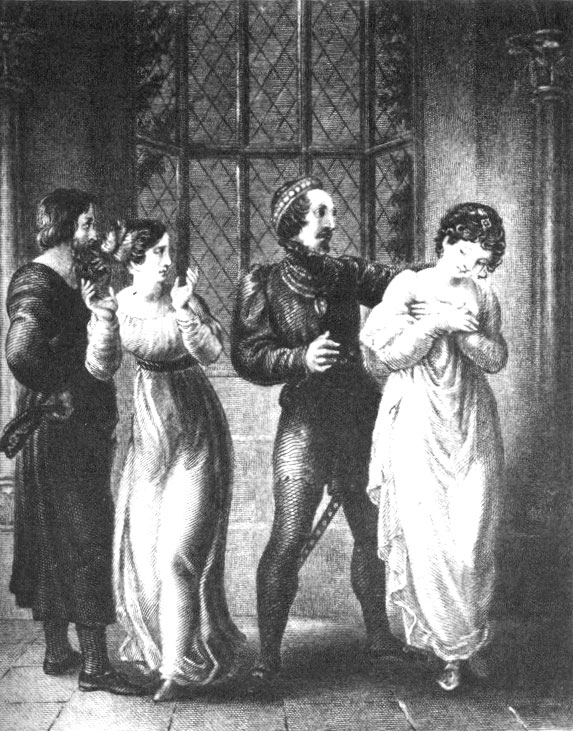
Coleridge's "Christabel"
-
What exactly happens in this poem?
-
What exactly is the class's opinion of Geraldine? Is she evil? What
exactly is her motivation?
-
To gain access to Leoline? Just to mix things up a bit (ala Satan)?
-
Beer, ed.: "Coleridge now wished to carry into his nature poetry . .
. questions of guilt and evil. . . . If the state of grace corresponds
to an innocent vision of nature and the fall of man is away from that vision,
is it ever possible for the innocent to redeem the experienced?" (257).
-
Dove=Innocence, Serpent=Experience
-
"Throughout this poem, evil is represented primarily as the veiling
of the good. The minimal light of the clouded moon [18-19] and half-hidden
eye of the snake [583-85] both speak of a vision that has been obscured
until it no longer controls human energies, which are left to the caprice
of the passion of the moment" (258).
-
If it had been completed, Beer foresees a happy, victorious ending for
Christabel.
Claire May, "'Christabel' and Abjection: Coleridge's
Narrative in Process/On Trial"
(Psychoanalytic Perspective)
-
Conventions about Narrative to which "Christabel" Fails to Adhere:
-
Stable Oppositions (Good/Evil, Life/Death) [important concept during
period surrounding French Revolution]
-
Narrative Time as Progressive, Linear, Uninterrupted
-
Poem opens with uncertainty about time (1-2), owl-cock (91ff.)
-
Verb Tense Shifts
-
Present: 1-2, 6-30, 35-36, 40-42
-
Past: 5, 31-34, 37-39, etc.
-
Stable, Univalent Language without "slippage" in meaning
-
Mastiff Bitch:
-
Described as Toothless
-
Described with Serpentine Imagery (see below as well):
-
"Beneath the Rock" (8)
-
"S"-alliteration builds 11-13
-
Identity of "My Lady" (13)
-
Narrator intrudes here and elsewhere: 13, 53-54, 69-70. 292-96,
621ff., concl. to Pt. 2)
-
Importance of Absent Mother in P/A theory
-
Henderson (see below): Christabel experiences a recovery/regression
to childhood, a pre-linguistic (i.e silenced) state.
-
Blending of Christian and Pagan Images
-
"Christian" CHRIST-ABEL [ironic?] goes to woods to pray amidst moss
& mistletoe ["dung-twig"] (29-36).
-
"Rupture" and Geraldine as symbol of recovery/reunion
-
Sir Leoline and Wife
-
Sir Leoline and Lord Roland
-
Snake imagery:
-
559: Bard's dream: Bard INTERPRETS snake as evil/unChristian
-
560: ll. 583-96
-
Old Testament: Is snake inherently EVIL?
Anya Taylor, "Coleridge's 'Christabel' and the Phantom
Soul"
(Feminist/Historicist Perspective)
-
"Christabel" as Female Version of "Ancient Mariner"
-
Christabel embodies STC's concept of phantom soul, "a soul that evaporates
for want of a connection with others."
-
"A will that does not contain the power of opposing itself to another
will is no will at all" (STC).
-
For STC, "there seems to be more and more phantom souls in the increasingly
mechanistic world."
-
STC expresses "belief in the necessity of preserving a distinction between
persons and things at a time when human beings were increasingly tabulated
as numbers, averages, and groups."
-
Marlon Ross: explains that STC, in response to WW [see also "Dejection:
An Ode"], "becomes abased before WW's masculinity"-- Paul Fry calls his
acceptance of WW's exclusion of his name and poems from later editions
of Lyrical Ballads as passive.
-
In fact, WW rejected "Christabel" for the 1800 edition, only to "borrow"
its themes of coopting of position in his "Michael"
-
Geraldine=WW, Christabel=STC
-
1st 230 lines: Christabel as active, assertive, in control of what happens
around her.
-
Sexuality is "peripheral" to the interaction between Christabel and
Geraldine.
-
The important thing, in Taylor's mind, is the "absorption" and "obliteration"
of Christabel by Geraldine, indicated by C's loss of voice.
-
"Thou had'st thy will (306) echoes "AM" (16).
-
"Christabel" asks questions about agency in slightly different way than
did "AM" (i.e. re: Mariner's shooting of albatross)
-
Beneath Leoline's mourning for his wife lies "an even more intense"
feeling of mourning for his broken friendship with his male friend, Lord
Roland.
-
Geraldine replaces both daughter and wife for Leoline.
-
Whereas "AM" "circles obsessively around a site of pain and guilt,"
"'Christabel' focuses on what we now realize are difficult transitions
on the personal development of young women, where what is done to them
often feels like their own fault."
-
How does STC know so much about the experiences/silencing of young women?
-
Death of sister in 1791?
-
Experience with WW?
Andrea Henderson, "Revolution, Response and 'Christabel'"
(Historicist Perspective)
-
Leoline: "a rich baron whose name suggests a kingly genealogy, while
his title ranks him among the lowest classes of nobility."
-
Opening description of Leoline and his castle suggests isolation and
decay (118, 145, 156-57, 163)
-
Leoline's "chivalric response" to Geraldine's story of abuse (434-37)="an
empty gesture"
-
Last oak leaf (49)=End of Leoline's line
-
Geraldine's "apparent purity, through its very excessiveness [abjection],
proves to be a sign of radical impurity, rather in the way that the pure
and rational ideals of the Revolution, carried further and further, finally
led to the destructive and irrational rigor of the Terror" (883).
-
Experience with Geraldine "infantalizes Christabel": "she is held like
a child, she smiles like an infant" (885).
-
"She is characterized by an integration and plenitude characteristic
of infancy but, in this case, achieved through strife" (886).
-
Coda: "Defenses are specifically being erected against the childish,
full, and passive status of which Christabel herself is the prime representative
in the poem" (894).
-
Real danger to Leoline is not Geraldine, but Christabel herself.
